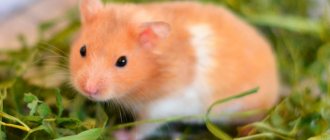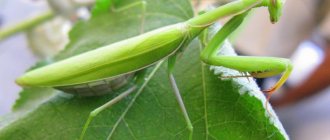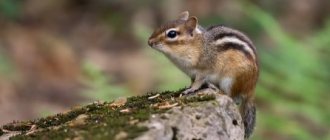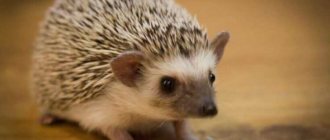By deciding to bring a playful and curious chipmunk into your home, you will certainly ensure that you are in a good mood every day. After all, you can watch these funny animals for hours, which will charge you with positivity for the whole day.
Many people cannot imagine their life without pets. Recently, it has become fashionable to have cute and funny chipmunks as pets. But since most pet lovers are little familiar with this furry animal, the question often arises whether it is possible to keep chipmunks in an apartment or house.
In this article we will look at the main aspects of keeping a chipmunk in captivity and how to properly care for it.
Buying a rodent
So, having bought or made a piece of paradise for a chipmunk, we go shopping for it. This is quite a rare and exotic animal, so you may need to make a reservation at a pet store. You can also look for advertisements in the newspaper or on Avito, but still the best option is to search for the nearest nurseries or breeders, and there are very good reasons for this:
- Pet stores often bring animals caught in their natural habitat and smuggled in. This one will never become tame, and can bring with it many exotic diseases;
- Also, a chipmunk can live in a store for quite a long time, and its psyche may be disturbed (constant strangers, bad food, constant lighting and noise). This also does not make him more flexible.
When purchasing an animal from breeders, you are guaranteed to receive a breeding animal that is not afraid of people, and if necessary, you can always get advice by phone. When purchasing, the chipmunk must be a baby, it must fit freely in a child’s palm, but at the same time already be independent (6-8 weeks old), as in the photo below. The coat should be shiny, and in general the animal should look healthy.
Little chipmunk
The price for an animal starts from 5,000 rubles.
Note: by the behavior of an animal you can determine whether it is domestic or caught in captivity. It’s strange, but domestic chipmunks designate a certain corner of the cage for the toilet, where they take crushed sawdust or other filler, and only go there. Wild rodents go to the toilet anywhere.
Diet
Chipmunks, like all rodents, love nuts, cereals, and seeds in milky maturity. They will also not refuse to snack on insects, their larvae, and small quantities of vegetables and fruits. They can also attack small animals and birds, but for the most part they are vegetarians.
Chipmunk eats corn
Do not forget to change the water in the sippy cup with fresh water twice a day. The chipmunk is not prone to becoming overweight, as he is constantly in active motion, so you don’t have to be afraid of overfeeding. Fill the feeder in the morning, and during the day the animal will dispose of the gifts itself - it will eat something, and take something back to the house for supplies.
At home, you can also feed with tree buds, shoots, berries and mushrooms. Sometimes they even feed them with cottage cheese and plain milk, but this is optional.
It is also worth going to the nearest pet store and buying special food for squirrels and chipmunks. These foods contain enough solid food to grind down the constantly growing incisors.
Offspring of chipmunks
At home, chipmunks do not hibernate in winter - the temperatures are not right. But if you want to try to breed offspring, then hibernation is necessary. This requires three conditions:
- A pair of young mixed-sex chipmunks;
- Double cage connected by one closing passage;
- Low temperatures, close to zero degrees.
With the onset of autumn, when the animals stock up, you will notice their aggressive mood towards each other. This is a good sign; it is time to place them in their cages, close the passage, and provide a cold temperature. For example, move the cages onto a glazed but unheated balcony
Install a thermometer so that in severe frosts you do not overcool the animals; the temperature should not be lowered below zero. Chipmunks will hide in their holes and sleep until spring, no care required
For example, move the cages onto a glazed but unheated balcony. Install a thermometer so that in severe frosts you do not overcool the animals; the temperature should not be lowered below zero. Chipmunks will hide in their holes and sleep until spring; no care is required.
When the temperature rises to 10 degrees, they will wake up and the female will begin to whistle with a characteristic sound reminiscent of gurgling. This is the call of the male, it’s time to open the passage between the cells, to which the male will react very quickly.
Pregnancy lasts about a month, after which tiny chipmunks will appear, there can be up to 12 of them in a litter.
Newborn chipmunk
The female takes all the care; it is better to place the male again. In about a month, the babies will become independent, and by 6 weeks they can be sold
In the ad, indicate that you have parents of babies, this is very important for potential buyers, that the animals were bred at home
But it so happens that they rarely bear offspring; why this is so is unclear. They do not want to reproduce in captivity.
And remember - we are responsible for those we have tamed!
Read with this
Video
Liked? Share with friends: Similar materials Didn't find what you were looking for? Use the search: Top most discussed 01/05/2019Business
Where can I get a million rubles in one day, urgently and free of charge?
Every person could use 1 million rubles in their life, but where can they get it? The state provides this kind of money for business development; in other cases, personal ingenuity and rich friends or relatives will help. There are many options.07/28/2017History
How to find a WWII participant by name in modern archives
A list of modern databases of participants in the Great Patriotic War, as well as detailed instructions for searching for participants in the Great Patriotic War of 1941-1945 by name in the archives of missing veterans and on the website of the Ministry of Defense. 07/20/2017Food and cooking
Fish batter: step-by-step and simple recipes
Looking for how to make fish batter? A selection of 25 simple step-by-step recipes with photos for cooking fillet. Basic versions of battered fish and recipes with mayonnaise, milk, mineral water, beer, cheese and others. These recipes will allow you to make lezion04/12/2016Wedding
Which countries allow same-sex marriage?
People with non-traditional sexual orientation are increasingly declaring themselves as equal citizens and want their marriages to be officially recognized in every country. Today, not many countries have decided to do this, but the list grows every year.04/12/2016Internet and computers
Keyboard secrets: how to write with characters that are not on the keyboard
In this article you will learn how, using a regular keyboard, insert various special characters into text: emoticons, arrows, etc.08/05/2016Entertainment
What are vipers (vapers), what do they vape, is it harmful or not?
Today, on the streets of big cities you can meet people exhaling clouds of steam. They have strange smoking utensils in their hands.04/28/2017Law
How much noise can you make in an apartment according to Russian law?
Observe the “Law of Silence” and do not bother your neighbors with loud music, even during the daytime. Otherwise, you may get into significant trouble.07/05/2017Entertainment
Hoverboard: what is it, how to choose and operate it correctly
What is a hoverboard? How to choose it correctly and on what principles does such a two-wheeled vehicle operate? Find out how to learn how to operate and charge it correctly. We will try to answer these and other questions in 04/21/2017 Technologies
How to track phone location: real methods
Is it possible to track the location of a phone without its owner knowing? Radar programs for parents that determine the coordinates of the device in real time, as well as restrictions on the operation of programs that track the coordinates of the phone.05.19.2017Health
How to get rid of mosquito bites in 5 minutes
Mosquito bites cause terrible itching, and if you do not resist the urge to scratch the bitten area, the itching becomes stronger and a blister appears. How to avoid unpleasant consequences?04/12/2016Money
How to become rich?
Becoming rich is the dream of millions. But how can one become one? Applicable to Russian reality, there are few ways to get rich. But they exist...04/26/2016Tops
Chipmunk price and place of sale
The chipmunk, like most of its relatives, should be purchased from rodent nurseries or pet stores. It is not recommended to make a purchase by hand, since it is quite possible to buy a not entirely healthy animal. The cost of such a pet may vary depending on the region of Russia. As for the center of the Russian Federation, the price of a chipmunk is about 5-6 thousand rubles.
A chipmunk at home will never cause problems with an unpleasant odor, since it is a very clean representative of rodents. With proper care and diet, such a pet will bring joy to all residents of the house, both children and adults, for many years.
Bottom line
The chipmunk is a funny and interesting animal that can delight its owners for almost a dozen years. But for this he needs suitable conditions of detention and good nutrition. Families with small children and people who do not have enough time to care for a pet should not make striped friends.
Chipmunks compare favorably with many rodents in their ability to adapt to home conditions. They are neat, clean, not demanding in terms of care and have a beautiful appearance. When a chipmunk lives in the house, there are no unpleasant odors, which is an additional argument in favor of purchasing such a pet.
Pros of keeping chipmunks at home
- Unlike their closest relative, squirrels, they have virtually no unpleasant odor. In addition, they are very clean and tidy: they relieve themselves only in a certain place in the cage, do not scatter food, and often clean their fur.
- They quickly get used to taking food from human hands, which means they easily become tame. Getting used to the owners, the chipmunk will never bite them. Even small children react calmly to stroking. Only if they do not cause them pain and discomfort.
- They are interesting to watch. Over time, a chipmunk develops a clear daily routine. Waking up in the morning, after washing, he usually takes out all the bedding from the house for airing. During the day he does other things that are important to him: brushing his fur, checking his food supplies, playing. By evening he returns the bedding to its place. At night, tightly seal all the cracks and entrances in the house.
- Chipmunks are quite simple to keep and eat. To live, they need a cage with thick bars, bedding - preferably wood, and also a house: there he hides and sleeps. There should also be a feeder and water bowl in the cage. If the cage has a wheel and labyrinths where the animal can arrange “rooms,” then such a cage can be called ideal. The diet should be varied, but not too expensive: vegetables, fruits, grains, cereals, lettuce, nuts.
- Chipmunks are not cowardly animals. They are curious and brave, treat people without fear, do not hide from him in the house, ask him for food and sit calmly in his arms.
- Home weather station: Chipmunks can sense rain and announce its approach with funny sounds.
- Unlike the familiar rodents - hamsters and decorative rats, which live no more than 4-5 years, chipmunks can live in captivity for up to 10 years. Of course, provided that it is on the correct content.
Entertainment and exercise equipment
Since chipmunks are quite active, they need to have several miniature exercise machines. In their absence, the animal will simply get bored and may die from this.
The simplest form of entertainment can be an ordinary stick. It is usually fixed not far from the house, at the corner of the cage. This is a great way of entertainment for chipmunks; they will happily run along a stick, as if on a branch.
A tree trunk can also be a great toy. It should be slightly smaller in size than the height of the cell, and up to 10 cm in diameter. The bark must be preserved. And to keep your pet safe, the log must be dried and disinfected. In addition, it is worth installing a fairly common running wheel.
You can also find a wide variety of swings, exercise machines, pipes and similar products in pet stores.
What do chipmunks eat?
They especially love:
- all types of nuts;
- acorns;
- sunflower seeds;
- apple seeds;
- cereals;
- berries;
- fruits;
- carrot.
Veterinarians advise not to feed animals almonds, which contain hydrocyanic acid. It is very harmful to all rodents. You should not treat your pet to peanuts and sunflower seeds very often due to their high fat content.
Fruits should be peeled, since the animal is very sensitive to chemical additives. Large amounts of fruits and vegetables can cause diarrhea. You should constantly monitor your diet.
The chipmunk's favorite treats include:
- sugar;
- cookie;
- hard-cooked milk porridge;
- cottage cheese.
An important condition for a balanced diet for an animal is the availability of soft and dry food. Chewing hard food allows the rodent to constantly wear down its growing incisors. In addition to solid food, it is advisable to provide your pet with pieces of chalk. This way, he can grind down his teeth whenever he wants.
The chipmunk needs to constantly consume enough animal protein.
Therefore, on his table should be present:
- eggs;
- raw meat;
- insects (bugs, grasshoppers);
- mealworm larvae.
No matter how complete your pet’s feeding is, he will still make himself an “emergency supply.” This is how it is laid down at the genetic level. In the wild, one chipmunk can provide itself with eight kilograms of food for the winter. Therefore, do not forget to regularly inspect the animal’s house and throw away spoiled food.
It is very important to change the water in the drinking bowl every day. Give preference to a waterer that is used for birds
After all, the chipmunk is very active. He's always carrying something, he's in a hurry somewhere, and he definitely won't be able to knock over such a drinking bowl.
Follow all our recommendations, and your pet will be fed, healthy and cheerful!
What to feed a chipmunk?
Organizing food for a chipmunk is quite simple due to its unpretentious diet. You can buy ready-made products or prepare food for your pet yourself.
Chipmunks prefer the following foods:
- nuts and acorns;
- sunflower seeds;
- cereals;
- fruits and berries.
For a small chipmunk, you need to first peel the fruit and not feed your pet almonds. In addition to the products listed above, chipmunks can also eat cottage cheese, cookies and cereals with milk. Be sure to check the freshness of food to avoid harm to health.
In addition, it is important that the chipmunk receives animal protein, sources of which can be eggs, raw meat and various insects. Since chipmunks tend to hoard food, check the areas designated for your pet's residence to remove spoiled supplies and prevent the animal from getting poisoned. It is also necessary to check how clean the water is and replace it on time.
Housing for a domestic chipmunk: cage or aviary?
- In their natural habitat, chipmunks make their home in medium-depth burrows. Despite the fact that in the wild this animal lives mainly at low altitudes, it climbs trees remarkably well. Therefore, they construct their “apartment” not far from trees or bushes.
- Due to the fact that the chipmunk is a very thrifty creature, its home usually consists of several holes in which it stores its food supplies. In addition, one of the “rooms” is used by the animal as a restroom.
- In the warm season, chipmunks can settle in small hollows or crevices of trees, not high from the ground.
- If you decide to have this funny rodent in your home, take care of its home in advance.
The domestic chipmunk is not too picky about living conditions. However, the cell intended for it must meet certain requirements:
- Be spacious enough, with several levels and sections, since the animal is very mobile and it desperately needs a lot of space to move. The cage is preferably about a meter in length and height, and about half a meter in width.
- Metal bars are required in the cage so that a small rodent cannot chew through them. In addition, the bars should not be spaced widely so that the miniature chipmunk does not slip between them and jump out of the cage. Sprinkle the bottom with sawdust, which should not be too fine so as not to irritate the animal’s eye mucosa. It is highly advisable to place a tray under the cage. Various garbage from it will be poured there.
The cage must have metal bars
- You must place a house in the cage in which the chipmunk can hide from prying eyes and rest, and also hide food supplies. Materials for this structure should only be of natural origin.
- In order for your animal to have the opportunity to equip its own home to its liking, do not forget to put the necessary things in the cage: leaves, hay, twigs. You should not put cotton wool in the cage because it can get into your chipmunk's food and cause him to have various health problems.
- The presence of all kinds of devices for games is mandatory: ladders, driftwood, shelves. They must be made of safe wood: pear, cherry, oak, apple tree. Plants such as broom and yew can be poisonous to chipmunks. Your active pet will be very pleased with a running wheel, where he can run around and maintain muscle tone and activity. The size of such a wheel should be half the size of a wheel intended for squirrels.
- And if you live in a private house and prefer to keep your chipmunk outside, make an enclosure for it. In a spacious enclosure you can keep several of these playful animals.
When constructing it, consider the basic requirements:
- An animal enclosure must be protected from rain and strong winds.
- It is better to make the walls of the enclosure from fine mesh so that street animals, birds and large insects cannot get into it.
- Lay a wire net at the bottom of the structure and cover it with peat and sawdust.
Perfect
- Place stones, driftwood, large branches and logs inside.
- Birdhouses can be used as houses for chipmunks. Remember that each animal must have its own birdhouse. In addition, additional houses are necessary for supplies, which chipmunks love to make. Place dry leaves and hay inside the birdhouses.
Conditions of detention
In natural conditions, chipmunks dig holes in dense areas of soil, for example, under tree roots or thick grass, in order to hide the entrance to their home as much as possible. In summer, the rodent can often be found in tree hollows and running along tree trunks in search of food, like squirrels, but with the advent of cold weather they move into underground burrows, where they hibernate.
For comfortable maintenance, you will have to recreate similar conditions. To do this, you will need to buy, but it is much faster and cheaper to make yourself, a spacious cage, which will be larger in height than in width, with many floors, ladders and houses.
Large rodent cage
The height of the cage should not be less than one meter, about the same in width, and about 50 cm in depth. In a word, the animal should not be constrained in its movements, it should constantly run, climb ropes and ropes, and jump across floors. If space allows, install a small squirrel wheel. The chipmunk is a very active rodent, and until it gets used to you, it will rush around the cage in search of shelter, so you should definitely install at least a couple of covered houses. In the future, the functions of the houses will be divided - some will serve as shelter, and others as food storage.
For feeding, use the most ordinary bowls for rodents and an automatic sippy cup installed at the bottom of the cage. It is also better to make the bottom of the cage retractable to make it easier to remove debris that collects there. If you want to bring the conditions closer to the most ideal, then the bottom can be covered with sawdust for digging minks, you can use peat. Any synthetic materials and wool should be excluded.
The cage material should only be metal; domestic chipmunks will quickly chew through any plastic or wood. The location of the cage should not be in a draft, direct sunlight, sources of loud noise or bright light. In general, there should be a quiet, calm corner.
Characteristics of a Chipmunk
Most of the chipmunk's characteristics are the same as all rodents, but there are some differences:
- Length – up to 17 cm;
- Color – white-orange, 5 longitudinal stripes on the back;
- Very curious and energetic, so keeping him out of a cage is not recommended. Jumping out onto a balcony or out an open window will not be difficult;
- Daytime lifestyle;
- Takes care of the cleanliness of his fur coat on his own. The cage only needs to be cleaned occasionally;
- Life expectancy is up to 5 years, in ideal conditions – up to 10.
By nature, chipmunks are fairly calm animals. In the summer, two or more individuals of either sex can be kept in one cage, the animals will play and frolic, but with the onset of autumn, when instinct tells them to prepare for hibernation, the rodents become irritable, and it is better to seat them. They get used to a person quite quickly with close contact, for example, feeding them by hand. It is not recommended to pick it up - it can cause a bite. Only over time, after two months, will the animal get so used to you and trust you that it will come to the edge of the cage to beg for a treat. That's when you can open the door and let the chipmunk jump onto your hand. In principle, this is a tame rodent, it just takes time to adapt.
Pet chipmunk
At the same time, you should not keep a chipmunk and small birds, like small parrots, in the same apartment; rodents naturally hunt them. Children should also only be allowed to cuddle pet chipmunks that you are sure will not bite. Although it is worth noting that they bite not so painfully and deeply, but still there is little desire to try it on yourself.
Once a year, between July and September, animals shed, which can cause allergies. Chipmunks themselves are very clean, and the cage will not have the specific mouse smell that is characteristic of most rodents. But during molting, it is better to be careful and have anti-allergy tablets in your home medicine cabinet.
Description of the animal
The animal is distinguished by its red color. Everyone knows that the chipmunk has five black and brown stripes along its back. The abdomen is usually light in color . The animals have small dark eyes and voluminous cheeks in which they hide food. These rodents reach 15–16 cm in length. This type of animal is clean, so their skin is always clean, beautiful and neat.
Chipmunks are active and energetic animals. In nature, they move quickly and love to explore new territories. But their small size does not contribute to a high life expectancy, since these rodents are often hunted by large animals. Animals dig minks for themselves among the roots of rotten stumps or trees. Chipmunks hibernate from the beginning of autumn until spring.
All these characteristics of the animal must be taken into account before you decide to bring it into your home.
Pet cage
Keeping a chipmunk at home requires the presence of a cage. It should only be metal, large in size, so as not to hinder the movement of the animal. Experts recommend the following cage dimensions: a height of at least 80 cm, with a width and length of about 40 cm, or a width of 50 cm, and a height and length of up to 1 m. It is advisable to equip the dwelling with: a shelf along one of the walls and a running wheel (half the size of for squirrels). Having the opportunity to run, your pet will be in good shape and in a good mood.
It is necessary to install a house on the territory of the cage for the animal to sleep. In addition, he will have somewhere to hide supplies. Approximate size of the house: 30x25x30 cm. The chipmunk sleeps in the nest, so he needs to put hay, leaves and rags inside the house.
Then you will be able to watch with emotion how he takes the bedding out of the house during the day to air it out, and before going to bed he brings it back. Veterinarians advise periodically performing a general cleaning of the house in order to remove old food supplies and disinfect it.
It is better to sprinkle the bottom of the cage itself with large wooden sawdust or fallen leaves. It is better not to use small sawdust.
The chipmunk likes to dig holes in the cage litter, and small sawdust can irritate its mucous membranes. The neat animal chooses one corner of the cage for its toilet. This makes caring for her much easier. You can find a cage with such a design that the floor is made like a drawer. Such cages are even more convenient to clean.
When choosing a place for the cage, you should take into account that in the spring the chipmunk loves to soak up the sun. But he does not tolerate the summer heat very well. At a temperature of +25 C it can die in direct sunlight. In the summer, he definitely needs shade, where he can hide from the heat and feel more comfortable.
House and food
The size of the house should be approximately 300×250×300 mm. To prevent it from being cold, you need to put straw and rags inside. Dry grass does not need to be compacted; it is enough to hammer its “dwelling” to the top without crushing it. The animal will make its own hole. You can also place a small haystack separately in the cage, with the help of which the chipmunk will bring his burrow to perfection. It is worth considering that every adult needs its own house.
During the day, chipmunks can take their bedding outside to air it out. At this moment you can clean up his house. At this time, it is necessary to remove old supplies and waste from the house. In addition, experts recommend disinfecting in hard-to-reach corners, as pathogenic bacteria can develop there. The bedding is also changed once a week.
Don't forget about the drinking bowl and food bowl. To supply water, it is best to use a special drinking bowl with a dispenser, then the pet will not be able to spill the liquid and leave itself without a drink.
In addition to sleeping and eating, the animal needs to move a lot, and therefore it needs “simulators”.
Breeding chipmunks at home
After waking up, a couple of rodents can be placed in one cage, which should be divided into 2 halves with a transition hole that could open if necessary, and close when the rodents are not in a mating mood at all. Experts recommend that after mating, it is better to immediately separate the male from the female. Throughout pregnancy, and it lasts 30 days for chipmunks, she will conflict with him, and he will distract her from motherhood. By the way, chipmunks are often heroic mothers, because at one time a chipmunk can bring up to 12 babies, whom she will raise herself until they are 1.5 months old and they become completely independent.
It is noteworthy that if in the breeding of some species of animals closely related mating is encouraged, among chipmunks such close ties between brother and sister, mother and son should be avoided - this often ends in the deformity of the offspring and its non-viability.
Well, chipmunks become ready for breeding when they turn one year old. They communicate their readiness by active behavior and a characteristic “chirp.”
Video about pet chipmunks
Today we talked about the features of keeping chipmunks at home, what is the best way to feed these animals, and how to properly care for them. We hope that the information from this article will be useful to you and will become useful when you decide to have such an unusual pet in your home.
If a chipmunk already lives in your house, be sure to share with our readers photographs of your pet on the pages of our VKontakte group, and also tell us about its habits. We are waiting for your stories, reviews and comments...
It is very easy to tame a chipmunk if it is in a large space and you can sit with it. The best way to tame a chipmunk is by sitting and holding a treat like nuts in your hands. The chipmunk will not be able to resist the treat. At first, as a rule, he will take food from hands, then
will become bolder and will not perceive you as a danger. Taming indoors will take longer, but should eventually produce results. Age also affects the difficulty of taming. It is better to tame young chipmunks. Taming can take anywhere from a few days to a year.
When you first bring your chipmunk home, it's best to leave him alone for the first few days so he can get used to his new surroundings and not become nervous. Talking to the chipmunk helps too. During such conversations, he remembers your voice, which will make it easier for him to get used to you. It is useful to regularly give your chipmunk reward through the bars of the cage in the form of treats. It is better not to look directly at the chipmunk, as this may frighten it. During your chipmunk's habituation, you need to be patient and take your time, as you risk ruining all the progress.
If you communicate with your chipmunk every day, then after a while he will rejoice at your arrival. After eating from your hands, you can try to put your hand into the chipmunk's cage. Most likely it will scare him the first time. You can put a treat on your palm, forcing the animal to climb onto it for a piece. Having climbed onto your hand for the first time, the animal will most likely grab the treat and immediately run away, but all this should ultimately lead to the fact that it will sit quietly and eat the treat in the palm of your hand.
How to tame a chipmunk
Tame your chipmunk with treats
It will take time before you can say that your pet chipmunk is completely tame. These nimble creatures are very touchy and vindictive, therefore, try not to conflict with them and do not offend them, because otherwise you will not have any friendship, but every time you decide to pick them up, the chipmunk will strive to bite your finger . And, by the way, his teeth are very sharp. So, it’s better to choose the carrot method and bribe the rodent with a treat. Offer him peanuts and get him to take them from your hand. By the way, an article about taming squirrels can help you in taming a chipmunk - they really have a lot in common with chipmunks.
Having realized that your hand does not pose any danger, but on the contrary - it treats you with all sorts of goodies, the chipmunk will show curiosity towards it, sniff your fingers, and then... climb onto your shoulder. From now on, you can consider that you are his friend.
Trying to pick up a chipmunk yourself, and even more so, grabbing its tail, is strictly prohibited. The latter is very dangerous for the health and life of the pet, and often ends in amputation of the tail.
Diseases
The lifespan of chipmunks is affected by diseases and injuries that the animal can receive while walking in a residential area. The most common injury is electrical burns.
The animal is gnawing on wires. When walking an animal in a room, it is necessary to remove all cables and household appliances from it.
If your pet begins to scratch itself frequently, it is necessary to examine it. Perhaps he has dermatitis. The cause may be a fungus, lichen, or an internal parasite that poisons the body with toxins, causing demodicosis. In the early stages, all diseases can be cured.
Demodicosis at a late stage leads to the death of the chipmunk. It is recommended to clean the cage daily, carry out antiseptic treatment with odorless products, and examine the pet once a year.
The optimal temperature for keeping an animal is 22-25 C. If the temperature is too high, the animal can get heatstroke or a heart attack.
The chipmunk falls, cannot get up, breathing quickens, the pet rolls its eyes. If these symptoms occur, take it to a quiet and cool place and water the fur.
If the animal is fed incorrectly, it may cause abdominal pain. The pet begins to rush around the cage, squeak, and scratch its belly. In this situation, it is recommended to consult a doctor. Perhaps it's just colic that is caused by excessive consumption of solid food.
It is necessary to take into account all the factors that shorten the life of a domestic chipmunk
It is recommended to take into account the preparatory period for hibernation. You should use good pet food and follow the diet
The cage should always be clean. Fungus develops on damp and dirty litter. When walking, you should not leave your chipmunk alone in the room.
What to feed a chipmunk at home?
Hibernation
Chipmunks hibernate in nature. They prepare supplies for the winter and have an increased appetite. Preparations begin in early autumn. An animal's burrow can contain up to 600 g of grain, dried berries, and acorns.
When the temperature drops to 0 C, individuals cover their homes with dry grass and soil and go on winter rest. In spring, animals wake up, come out of their burrows, and begin to feed heavily.
Domestic animals of the Asian species retain these natural instincts, but if preparations for the winter period are not carried out correctly, the animal will die. Individuals of the American species are active throughout the year:
- for a domestic chipmunk, it is recommended to purchase a double cage or make a compartment in the display case for winter rest;
- when a pet begins to stock up and eat a lot, this means that it is preparing for winter. They put rags, hay, and paper in his cage. The animal uses these materials to insulate its shelter;
- the temperature in the room where the animal is located is reduced. By the end of autumn it is brought to zero. It is recommended to insulate the balcony and take the pet to a cold room;
- at the end of autumn, the pet reduces its appetite. His food portion is reduced. Then, the bowls are completely removed from the cage;
- The chipmunk himself will decide when it is time for him to sleep. You should not disturb him; waking him up and feeding him is not recommended. If the time has come for hibernation, then the animal should fall asleep;
- the animal closes all entrances to its home and remains inside.
The chipmunk should always be given a lot of food so that he can prepare for the winter. If there is not enough food for him in the winter, then the pet may not wake up.
Habitat, lifestyle
Chipmunks live in coniferous, deciduous and mixed forests; most often they can be found in woodlands, forest edges, river valleys, in cluttered areas of the forest, where there is dead wood. They settle in the mountains to the limit of forest distribution. Avoids park-type forests without undergrowth and windfall, as well as swampy areas. The eastern chipmunk often lives among rocks and rocky outcrops.
In natural conditions, chipmunks feed mainly on the seeds of various wild and cultivated plants, from time to time diversifying their diet with insects and mollusks. The animals are excellent at climbing trees; it is in the trees that they obtain most of their food.
In thick grass, under fallen trees, their roots and stumps, chipmunks dig holes with many rooms, hiding the entrance among the branches of bushes and stones.
Each animal has a separate home; chipmunk holes are often located close to, or even close to, each other - animals can create entire colonies. But by their nature, these animals are loners. Everyone has their own area, and violating the boundaries of the latter leads to heated fights. In grain fields you can often meet a large number of chipmunks, but still each of them tries to emphasize their isolation - the animals mark their areas with urine or body odor, which they leave when they rub their bellies on the ground. Each individual strictly ensures that its neighbor does not violate the border.
The chipmunk's home has all the necessary rooms: an entrance hall, a bedroom, a storage room and even a restroom. The sleeping area is always well lined. The pantries store provisions for the winter - seeds, cereals, acorns, nuts, etc. Each animal weighing 100 g collects from 2 to 8 kilograms of food reserves for the winter!
It is clear that even a kilogram of provisions will be more than enough for the winter, but instinct does not allow the rodent to sit still and forces the animal to stock up, and the more, the better. The neat rodent carefully sorts provisions and puts them in separate pantries. Chipmunks begin harvesting in the second half of August. Supplies are carried like regular food, in cheek pouches, often covering a distance of more than a kilometer.
Winter hibernation for the animals is long, from October to April, over almost the entire distribution area. They spend all this time in the sleeping quarters of their burrow, sometimes waking up to eat. During the hibernation period, as a rule, chipmunks do not eat all the reserves, leaving most of them for the hungry spring. If any animal ruins our hero’s reserves (mostly bears are guilty of this), then wintering may end in failure for the animal.
There are rumors that chipmunks are suicidal animals; they allegedly hang themselves from branches if their storerooms are emptied. However, these are nothing more than tales of Siberian hunters. Animals have an extremely developed instinct of self-preservation, and they cannot have such a concept as “commit suicide.”
After chipmunks emerge from hibernation, they begin the rut. During this period, females declare their mating mood, calling males with characteristic sounds similar to a thin whistle.
What do you need to know before buying a chipmunk?
Chipmunks are considered rare pets, so their purchase must be made either in special stores or from breeders. Before the final decision is made to purchase this animal, make sure of its authenticity, try to find out about the parents and health status. It is recommended to buy a chipmunk in a nursery or from breeders, because animals in pet stores can live for a long period of time and become the owner of mental disorders provoked by numerous buyers and other factors.
You have a much better chance of buying a pet that can quickly get used to new conditions when you contact a breeder. In order to determine whether a chipmunk is domestic or wild, just look at their way of going to the toilet - tame animals choose a certain area in the cage for this purpose, while wild ones tend to use the entire space for their needs.
The average cost of a chipmunk is 5-6 thousand rubles. The best time to purchase a pet is spring and summer. Animals are most active during this period, which means it will be possible to monitor their condition. With the onset of autumn, they can become aggressive, and in winter they can be apathetic or simply hibernate, and then determining the state of their health will be problematic. Immediately after you have purchased a pet, or even before purchasing, you need to show your chipmunk to a veterinarian.
Walks
Chipmunks are mobile and active animals. When living in natural conditions, they can move a distance of more than 12 km per day. That is why it is important for the owners of these animals to ensure their active lifestyle. Walking is suitable for this purpose. The first time after acquiring a pet - for about three weeks, do not let the chipmunk out for a long time so that it cannot escape. Gradually accustom the animal to walks, be sure to control it at the same time, because... following its instincts, the pet can chew on various interior items.
Experts advise closing the windows while walking so that the chipmunk does not run away, becoming interested in tree branches. Isolate other pets - you can walk your chipmunk in a separate room with the doors closed. In cases where he refuses to return to the cage, attempts to catch him will be futile. Here it is better to use a treat that needs to be placed in the cage.











